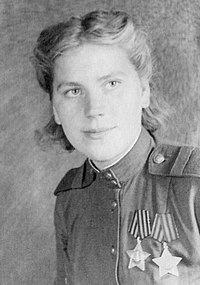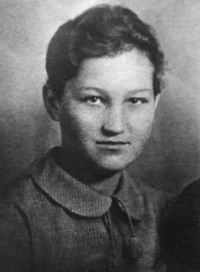
Marina Mikhaylovna Raskova was the first woman in the Soviet Union to achieve the diploma of professional air navigator. Raskova went from a young woman with aspirations of becoming an opera singer to a military instructor to the Soviet's first female navigator. She was the navigator to many record-setting as well as record-breaking flights and the founding and commanding officer of the 587th Bomber Aviation Regiment, which was renamed the 125th M.M. Raskova Borisov Guards Dive Bomber Regiment in her honor. Raskova became one of over 800,000 women in the military service, founding three female air regiments, one of which eventually flew over 30,000 sorties in World War II and produced at least 30 Heroes of the Soviet Union.
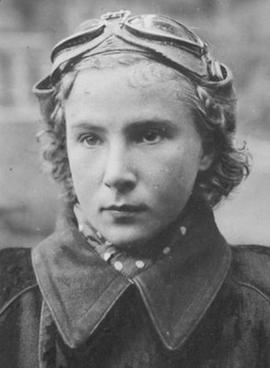
Lydia Vladimirovna Litvyak, also known as Lilya, was a fighter pilot in the Soviet Air Force during World War II. Historians estimate for her total victories range from thirteen to fourteen solo victories and four to five shared kills in her 66 combat sorties. In about two years of operations, she was the first female fighter pilot to shoot down an enemy aircraft, the first of two female fighter pilots who have earned the title of fighter ace and the holder of the record for the greatest number of kills by a female fighter pilot. She was shot down near Orel during the Battle of Kursk as she attacked a formation of German aircraft.
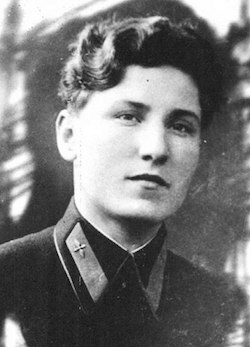
Yekaterina Vasilyevna Budanova, nicknamed Katya (Катя), was a fighter pilot in the Soviet Air Force during World War II. Usually credited with five or more aerial victories, along with Lydia Litvyak, she is often considered one of the world's two female fighter aces. She was shot down by either Luftwaffe ace Georg Schwientek of JG 52 or ace Emil Bitsch, of JG 3.

"Night Witches" was a World War II German nickname for the all-female military aviators of the 588th Night Bomber Regiment, known later as the 46th "Taman" Guards Night Bomber Aviation Regiment, of the Soviet Air Forces. Though women were officially barred from combat at the time, Major Marina Raskova used her position and personal contacts with the Soviet leader Joseph Stalin to obtain permission to form female combat units. "Combat facilitated and ushered in a reluctant acceptance of women in military, based more upon practicality and necessity than for equality". On October 8, 1941, an order was issued to deploy three women's air-force units, including the 588th Regiment. The regiment, formed by Raskova and led by Major Yevdokiya Bershanskaya, was composed primarily of female volunteers in their late teens and early twenties.

Valentina Stepanovna Grizodubova was one of the first female pilots in the Soviet Union awarded the title Hero of the Soviet Union and the only female Hero of the Soviet Union to also be awarded the title Hero of Socialist Labour.

Women in the Russian and Soviet militaries have played many roles in their country's military history. Women played an important role in world wars in Russia and the Soviet Union, particularly during World War II.

Mariya Ivanovna Dolina was a Pe-2 pilot and deputy squadron commander in the women's 125th “Marina M. Raskova” Borisov Guards Bomber Regiment. She was active primarily on the 1st Baltic Front during World War II. On 18 August 1945 she was awarded the title Hero of the Soviet Union.

Irina Fyodorovna Sebrova was a flight commander in the women's 46th Taman Guards Night Bomber Aviation Regiment, also known as the Night Witches, during the Second World War. She was awarded the title Hero of the Soviet Union on 23 February 1945 for her first 825 bombing missions. By the end of the war she totaled over 1,000 sorties, more than any other female pilot.
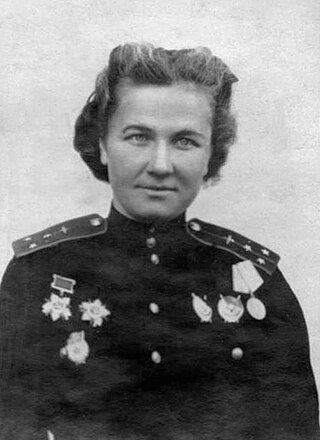
Nadezhda Vasilveyna Popova was a squadron commander in the 46th Taman Guards Night Bomber Regiment during the Second World War who achieved significant domestic publicity after completing 18 bombing sorties in one night with navigator Yekaterina Ryabova. Awarded the title Hero of the Soviet Union on 23 February 1945 for completing 737 sorties, she was featured on the cover of Komsomolskaya Pravda and in many other major Soviet publications during the war.

Klavdia Yakovlevna Fomicheva was a squadron commander in the 125th Guards Dive Bomber Regiment during the Second World War who was awarded the title Hero of the Soviet Union on 18 August, 1945.

Raisa Yermolayevna Aronova was a Soviet Polikarpov Po-2 navigator and pilot of the 588th Night Bomber Regiment, later renamed 46th Guards Night Bomber Regiment during World War II. She received the title of Hero of the Soviet Union on 15 May 1946 for completing 914 night bombing missions against Axis forces.

Yevdokiya Borisovna Pasko was a squadron navigator in the Soviet all-female 46th Taman Guards Night Bomber Aviation Regiment during World War II. For her successes in the war, she was honored with the title of Hero of the Soviet Union on 26 October 1944.
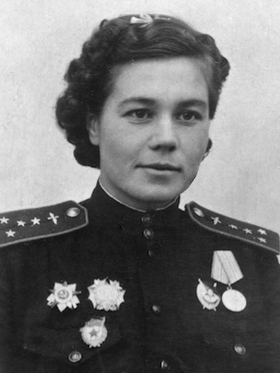
Olga Aleksandrovna Sanfirova was a captain and squadron commander in the 46th Taman Guards Night Bomber Aviation Regiment during World War II. She was posthumously awarded the title Hero of the Soviet Union on 23 February 1945, making her the first Tatar woman awarded the title.

Larisa Nikolayevna Rozanova was a Soviet pilot and later the senior navigator of the 46th Taman Guards Night Bomber Aviation Regiment, nicknamed the "Night Witches" during World War II. For successfully completing 793 sorties, she was declared a Hero of the Soviet Union on 23 February, 1948.

Yevdokiya Ivanovna Nosal was a junior lieutenant and deputy squadron commander in the 588th Night Bomber Regiment during World War II. She was posthumously awarded the title Hero of the Soviet Union on 24 May 1943, making her the first woman pilot to be honored with the title during the war.

Zoya Ivanovna Akimova née Parfyonova was a senior lieutenant and deputy squadron commander in the 46th Taman Guards Night Bomber Aviation Regiment during World War II. For completing 815 sorties during the war, she was awarded the title Hero of the Soviet Union on 18 August 1945, making her the only woman from Chuvashia to receive the title.
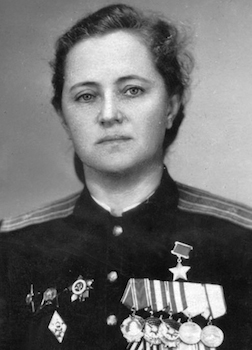
Yevgeniya Andreyevna Zhigulenko was a pilot and navigator in the 46th Taman Guards Night Bomber Aviation Regiment of the Soviet Air Forces during World War II who was awarded the title Hero of the Soviet Union.

The 125th Borisov Guards Bomber Aviation Regiment named after Marina Raskova was one of the three Soviet women's aviation regiments founded by Marina Raskova at the start of the Second World War. The unit was founded as the 587th Bomber Aviation Regiment in the 223rd Bomber Air Division, 2nd Bomber Aviation Corps of the 16th Air Army on 8 October 1941, and later honored with the guards designation, being renamed 125th Guards Bomber Aviation Regiment in September 1943 and reorganized into 4th Guards Bomber Aviation Division, 1st Bomber Aviation Corps, 3rd Air Army, in the 1st Baltic Front. Unlike the 46th Taman Guards Night Bomber Aviation Regiment, which used Polikarpov Po-2 utility aircraft, the unit was assigned modern Petlyakov Pe-2 aircraft, which caused some resentment among male units that had older aircraft. Throughout the course of the war, the unit flew 1,134 missions and dropped over 980 tons of bombs on the Axis.
The 586th Fighter Aviation Regiment was one of the three Soviet women's aviation regiments founded by Marina Raskova at the start of the Second World War after she convinced Joseph Stalin to allow her to form three all-female aviation regiments. The regiment was originally equipped with Yakovlev Yak-1 aircraft and later acquired Yak-7 and Yak-9 aircraft in 1943. Sorties were conducted to patrol over military installations and carry out defensive missions. While the regiment was intended to be an all-female regiment it became coed with a preponderance of females after regimental commander Tamara Kazarinova transferred to another unit in October 1942 and was replaced by a man, Aleksander Gridnev. The regiment yielded two female flying aces, Lydia Litvyak and Yekaterina Budanova, who were posthumously awarded the titles Hero of the Soviet Union and Hero of the Russian Federation respectively.

Galina Dmitrievna Tenueva née Lomanova was a flight commander of the 1st squadron in the 125th Guards Bomber Aviation Regiment and one of the nine women awarded the Order of Alexander Nevsky.

